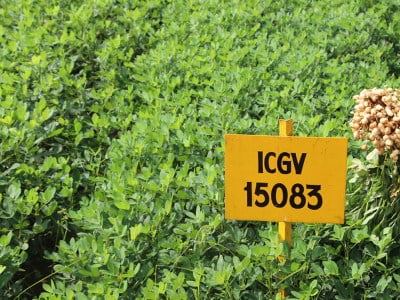Girnar 4 and Girnar 5 Groundnut Varieties | UPSC | Why In The News ?
- Two High Oleic Groundnut Varieties, Girnar 4 & Girnar 5 Developed by ICAR-ICRISAT
Girnar 4 and Girnar 5 Groundnut Varieties
Key Points
- Groundnut is the main oil seed crop in India and it plays a major role in bridging the vegetable oil deficit in the country.
- Groundnuts in India are available throughout the year due to a two-crop cycle harvested in March and October.
- Two high-oleic groundnut varieties
- ICAR-Directorate of Groundnut Research, Junagadh in collaboration with the ICRISAT has developed two high oleic groundnut varieties for the first time in India, namely Girnar 4 and Girnar 5.
- In normal groundnut the oleic acid content varies from 40-50% while these new varieties have nearly 80% of oleic acid.
- Girnar 4 and Girnar 5, are identified for cultivation as kharif crop in five major groundnut growing states, namely Gujarat, Rajasthan, Andhra Pradesh, Karnataka and Tamil Nadu.

Oleic Acid
- Oleic acid is a monounsaturated fatty acid with health benefits including reduced risk of developing cardiovascular diseases.
Top 10 Groundnut Producing States in India
- Gujarat
- Rajasthan
- Tamil Nadu
- Andhra Pradesh
- Karnataka
- Madhya Pradesh
- Maharashtra
- West Bengal
- Uttar Pradesh
- Odisha
About Groundnut & Climate Need For Cultivation
- Climatic conditions such as temperature and rainfall significantly influence the groundnut production.
- Warm and moist conditions are very favorable than cool and wet climate, which results in slow germination and seedling emergence, increasing the risk of seed rot and seedling diseases.
- Temperature is a major environmental factor that determines the rate of crop development.
- Temperatures above 35°C inhibit the growth of groundnut.
- Optimum mean daily temperature to grow is 30°C and growth ceases at 15°C.
- For rapid emergence, soil temperature above 21°C is needed.
- The optimum temperature for the most rapid germination and seedling development is about 30°C.
- A minimum 100 – day optimum temperature growing season is necessary for successful groundnut crop production.
- Adequate and well distributed rainfall during the growing season, especially during flowering, pegging and pod formation stages, is essential for maximum yield and quality of groundnut.
- Groundnut is grown in areas receiving 600 to 1500 mm of rainfall.
- However, the crop can be grown successfully with a rainfall of 1250 mm.
MACS 6478 wheat variety | UPSC
The amount of rainfall required:
- Pre-sowing operations (preparatory cultivation) 100 mm
- Sowing 150 mm
- Flowering and pod development 400-500 mm
The groundnut crop cannot stand
- Frost for long
- Severe drought
- Water stagnation
Source : ICRISAT








